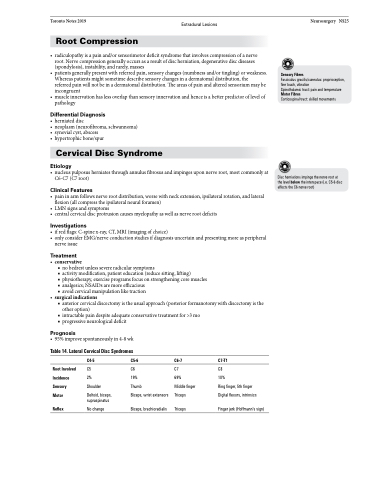Page 823 - TNFlipTest
P. 823
Toronto Notes 2019 Extradural Lesions Root Compression
• radiculopathyisapainand/orsensorimotordeficitsyndromethatinvolvescompressionofanerve root. Nerve compression generally occurs as a result of disc herniation, degenerative disc diseases (spondylosis), instability, and rarely, masses
• patientsgenerallypresentwithreferredpain,sensorychanges(numbnessand/ortingling)orweakness. Whereas patients might sometime describe sensory changes in a dermatomal distribution, the
referred pain will not be in a dermatomal distribution. The areas of pain and altered sensorium may be incongruent
• muscleinnervationhaslessoverlapthansensoryinnervationandhenceisabetterpredictoroflevelof pathology
Differential Diagnosis
• herniateddisc
• neoplasm(neurofibroma,schwannoma) • synovialcyst,abscess
• hypertrophicbone/spur
Cervical Disc Syndrome
Etiology
• nucleuspulposusherniatesthroughannulusfibrosusandimpingesuponnerveroot,mostcommonlyat C6-C7 (C7 root)
Clinical Features
• paininarmfollowsnerverootdistribution,worsewithneckextension,ipsilateralrotation,andlateral flexion (all compress the ipsilateral neural foramen)
• LMNsignsandsymptoms
• centralcervicaldiscprotrusioncausesmyelopathyaswellasnerverootdeficits
Investigations
• ifredflags:C-spinex-ray,CT,MRI(imagingofchoice)
• onlyconsiderEMG/nerveconductionstudiesifdiagnosisuncertainandpresentingmoreasperipheral
nerve issue
Treatment
• conservative
■ no bedrest unless severe radicular symptoms
■ activity modification, patient education (reduce sitting, lifting)
■ physiotherapy, exercise programs focus on strengthening core muscles ■ analgesics; NSAIDs are more efficacious
■ avoid cervical manipulation like traction
• surgicalindications
■ anterior cervical discectomy is the usual approach (posterior formanotomy with discectomy is the
Neurosurgery NS25
Sensory Fibres
Fasciculus gracilis/cuneatus: proprioception, fine touch, vibration
Spinothalamic tract: pain and temperature Motor Fibres
Corticospinal tract: skilled movements
Disc herniations impinge the nerve root at the level below the interspace (i.e. C5-6 disc affects the C6 nerve root)
other option)
■ intractable pain despite adequate conservative treatment for >3 mo
■ progressive neurological deficit
Prognosis
• 95%improvespontaneouslyin4-8wk
Table 14. Lateral Cervical Disc Syndromes
Root Involved Incidence Sensory Motor
Reflex
C4-5
C5
2%
Shoulder
Deltoid, biceps, supraspinatus
No change
C5-6
C6
19%
Thumb
Biceps, wrist extensors
Biceps, brachioradialis
C6-7
C7
69%
Middle finger Triceps
Triceps
C7-T1
C8
10%
Ring finger, 5th finger Digital flexors, intrinsics
Finger jerk (Hoffmann’s sign)


